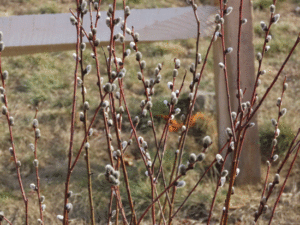(by Melissa Moore)
Signs of spring abound this time of year. We may loathe the mud, but all other seasonal signposts are greeted with enthusiasm. Pussy Willows are one of the first to appear signaling the end of another long winter.
Pussy Willows are either male plants or female plants. They belong to a group of plants called dioecious which means the plants have male or female reproductive organs in separate individual plants. Holly and Ginko trees belong to the same group. Pussy Willows, or Salix discolor are easy to grow from a rooted cutting or even from seed. If you’re looking for the largest, feathery tufts in March you will need to make sure you have a male plant. Gardners are encouraged to plant more than one pussy willow and check with the nursery staff to see if they have a record of the plant’s sex. If there are large fuzzy gray tufts that burst into a yellow ball of stamens you have a male plant. Female pussy willows have smaller feathery nubs.

The Pussy Willow prefers moist, wet soil. It will thrive in full sun or part shade. It grows to a maximum height of 15-20 feet, and will often appear multi-stemmed. Well timed pruning encourages the straightest stems. It is a great specimen tree or landscape tree.
Folklore offers a charming account for how this shrub-like tree got its name. At the river’s edge, a litter of kittens was chasing butterflies and accidentally fell in. The kittens struggled, and the mother feline caterwauled with a shrill cry seeking assistance. The long, flexible willow trees hugging the moist ground along the river came to their rescue. They extended their branches into the rushing water where the kittens grabbed on tight and were lifted to safety. The tiny tufts that appear each spring are reminiscent of where the kittens clung to the branches.
Photos by Rebecca Suomala.
